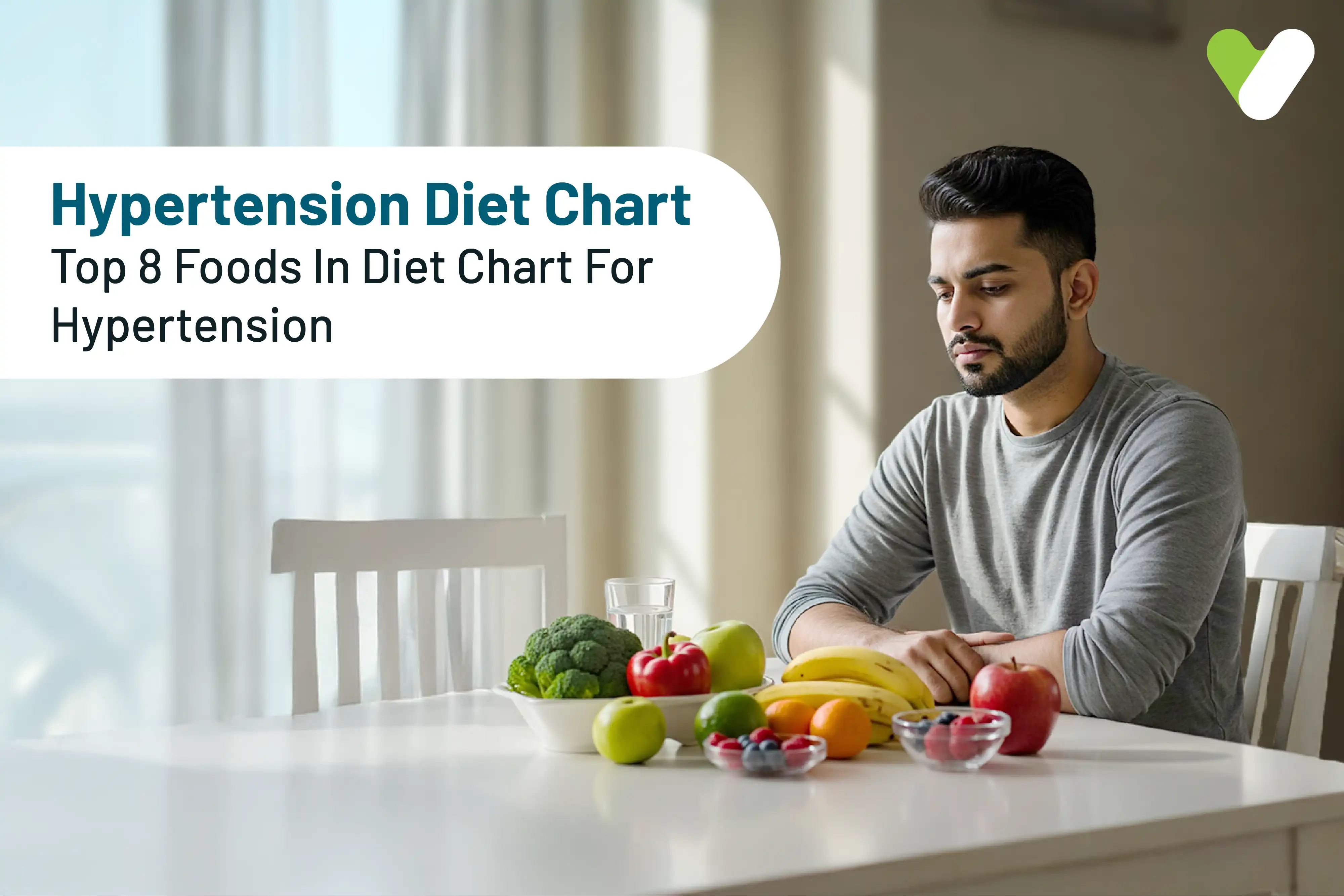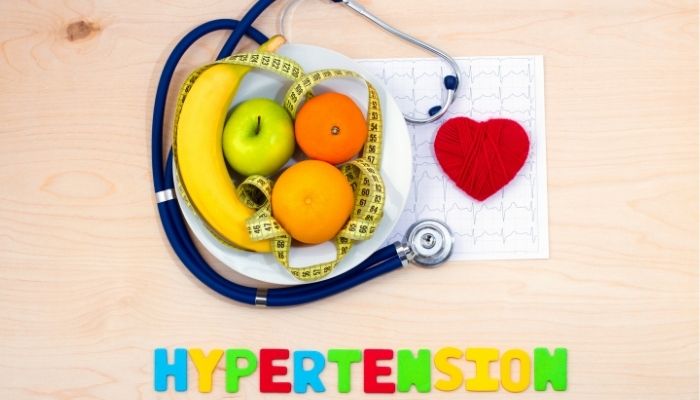Mr. Patel (50-years-old) works in a private company in Ahmedabad. He is a foodie and is fond of licking his fingers after finishing his food. Mr. Patel was diagnosed with hypertension over the past few months. His blood pressure was on the higher side when he consulted a doctor. The doctor gave him some medicines and also a diet chart for hypertension.
If your blood pressure is 140/90 and above, it is hypertension and 180/120 and above is severe. Some people with high blood pressure have no hypertension symptoms. If your blood pressure readings are 140/90 or above for several weeks, then you are hypertensive.
If you have blood pressure, this high pressure puts extra load on your heart and blood vessels. So you become more prone to heart attack or stroke. High blood pressure can damage your heart and kidney and is also linked to some forms of dementia. People may get blood pressure without any particular reason.
How to Control High Blood Pressure?
Though medications are effective in controlling your blood pressure, your doctor will prescribe a blood pressure diet chart to minimize your pressure. Your doctor will recommend starting the DASH (dietary approaches to stop hypertension) to improve your condition. The diet is simple and easy to follow.- Eat more fruits, vegetables, low-fat dairy products
- Get rid of food items high in saturated, cholesterol and trans fats
- Consume whole-grain foods, fish, poultry, and nuts
- Restrict sodium, sweets, sugary drinks, and red meat consumption
Dash Diet Plan For Hypertension
To follow a DASH diet you need to eat certain number of servings from various food groups. The number of servings may vary based on the number of calories you need per day. Start with a base diet and then, you can change it gradually.
First, limit yourself to 2,400 milligrams of sodium per day (about 1 teaspoon). Once you get used to that, you can cut down to 1,500 milligrams of sodium per day (about 2/3 teaspoon). These amounts include all sodium you consume in a day including sodium in foods and what you are adding while cooking.
Also Read : Foods to eat in hypertension
Dash Diet For High Blood Pressure Patients - Top Tips
- Consume more green and leafy vegetables at lunch and dinner.
- Consume a bowl of fruit in your meals or you can add a serving of fruit as a snack. Canned and dried fruits are convenient and healthy, but check carefully that they don't come up with added sugar
- Use only half a serving of butter, margarine, or salad dressing. Always prefer low-fat or fat-free condiments.
- Drink low-fat or skim dairy products any time instead of using full-fat or cream.
- Restrict meat to 6 ounces a day. Prepare some vegetarian meals.
- Incorporate more vegetables and dry beans into your diet.
- Don’t eat chips or sweets, rather you can take unsalted pretzels or nuts, raisins, low-fat and fat-free yogurt, frozen yogurt, unsalted plain popcorn with no butter, and raw vegetables.
- Check food products before consuming them and choose those items that are lower in sodium.
Indian Diet Plan For High Blood Pressure Patients
The following diet chart for hypertension patients in India ensures that you lower your blood pressure while you stay satiated all day.| Meal | Duration | Types of Food |
| 1 | Early Morning | Take Coriander/Jeera Water with Soaked and Peeled Almonds in the early morning |
| 2 | Breakfast | Wheat (50%) + Wheat Bran stuffed roti with seasonal veg + curd without salt (can also add roasted jeera or dried mint leaves) or Mint Chutney |
| 3 | Mid Morning Snack | Youn can drink Coconut Water |
| 4 | Lunch | Brown bread vegetable sandwich/wheat (50%) + wheat bran (50%) roti with seasonal veg + curd (optional) |
| 5 | Evening Drink | You can take Kacchi lassi (80% water and 20% milk)/Peppermint Tea/Milk tea without Sugar/Hibiscus tea or any other flower tea in evening drink to control high blood pressure |
| 6 | Evening Snack | You can take any Any fruit or salad (no salt, can add lemon) |
| 7 | Dinner | You can take Bran flakes chaat/Cooked vegetables bowl/Mix veg raita/Wheat bran flakes in milk or curd in the dinner |
| 8 | Late Evening Snack | You can take Chamomile Tea or Hot Water or Hot Lemon Water in the late evening sanck as per your choice |
Dash Diet Chart For High BP Patients
The DASH diet suggests getting:- Grains: 7-8 daily servings
- Vegetables: 4-5 daily servings
- Fruits: 4-5 daily servings
- Low-fat or fat-free dairy products: 2-3 servings daily
- Meat, poultry and fish: 2 or fewer servings daily
- Nuts, seeds and dry beans: 4-5 servings per week
- Fats and oils: 2-3 servings daily
- Sweets: restrict less than 5 servings per week
8 Best Foods That Help Lower Blood Pressure
Following are some foods you can add in your high blood pressure diet menu that will help you lower blood pressure -- Banana- These easy-to-get fruits aren’t just sweet, they are low in sodium too. They also have potassium that reduces blood pressure.
- Spinach- This green leafy vegetable is low in calories, high in fiber and full of essential nutrients like potassium, folate, magnesium, etc. that minimizes blood pressure.
- Celery- Celery stalks lowers high blood pressure. It has phytochemicals called phthalides that reduces muscle tissue in the artery walls. This improves blood flow and reduces blood pressure.
- Oatmeal- Oatmeal has high fiber and helps your body to maintain healthy blood pressure. Oatmeal reduces both your systolic and diastolic pressure.
- Avocado- Avocado has oleic acid that reduces high blood pressure and cholesterol levels.
- Watermelon- It has an amino acid called L-citrulline that reduces blood pressure.
- Beetroot- This red root vegetable has nitrates that relaxes your blood vessels and increases blood flow.
- Oranges-Oranges are the best fruit for vitamin C. This fruit reduces your blood pressure.
3 Foods to Avoid in High Blood Pressure (Hypertension)
You need to restrict your salt intake if you have high blood pressure. Let’s take a look at what other ingredients you should restrict in your high BP diet chart are given below:-- Sugar: Sugar has no nutritional value yet it adds calories to your daily food intake. If you have blood pressure, you should be very careful regarding your sugar consumption. The American Heart Association recommends adult women not to eat sugar above 6 teaspoons (20 grams) a day and adult men 9 teaspoons, or 36 grams.
- Nitrates: Sodium nitrate is used as preservatives in salty, processed meats like bacon and others. All these ingredients will increase your risk of heart disease and cancer. So, consume lean, fresh meats and seafood over-processed items.
- Trans Fat: Trans fats are very dangerous for you if you have high blood pressure. Processed food items like crackers, chips, and cookies should be discarded as much as possible.
BP Patient Diet Chart - The Bottom Line
Though blood pressure or hypertension is very common among people (irrespective of their gender), it can be dangerous for your health if you don’t pay attention to it. Along with medications, you need to follow a high blood pressure (BP) food chart to manage your condition. Talk to a dietician who will help you with what you should consume when you have higherConsult a Cardiologist today!




